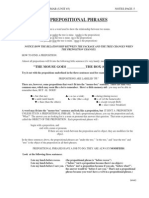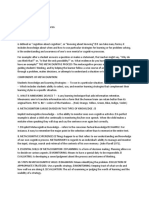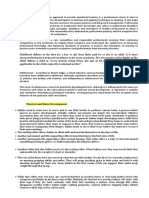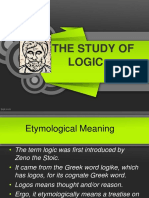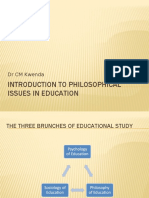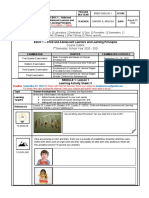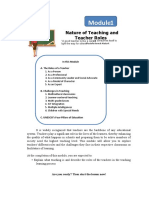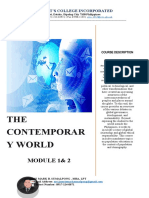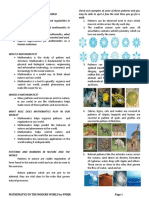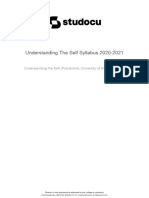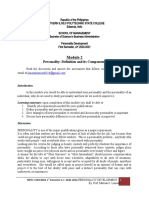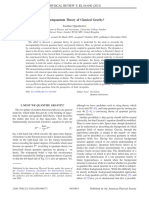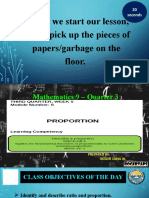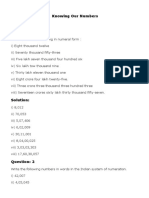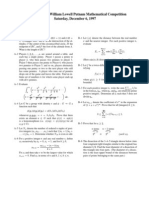Fibonacci Sequence
Fibonacci Sequence
Uploaded by
Jhon Rainiel NogralesCopyright:
Available Formats
Fibonacci Sequence
Fibonacci Sequence
Uploaded by
Jhon Rainiel NogralesCopyright
Available Formats
Share this document
Did you find this document useful?
Is this content inappropriate?
Copyright:
Available Formats
Fibonacci Sequence
Fibonacci Sequence
Uploaded by
Jhon Rainiel NogralesCopyright:
Available Formats
Mathematics in the Modern World 1
Chapter 1
As rational creatures, we tend to identify and follow patterns, whether consciously or
subconsciously. Recognizing patterns feels natural, like our brain is hardwired to recognize
them. Early humans recognized the repeating interval of day and night, the cycle of the moon,
the rising and falling of tides, the changing of seasons, flora and fauna such as the arrangement
of leaves, flower petals, or even the shape of snowflakes and snail’s shell. Awareness of the
patterns allows the human to survive. In this chapter, we will be looking at patterns and
regularities in the world, and how mathematics comes into play, both in nature and human
endeavors.
LEARNING OBJECTIVES:
At the end of the lesson, the students are expected to:
1. Identify patterns in nature and regularities in the world.
2. Articulate the importance of mathematics in one’s life.
3. Argue about the nature of mathematics, what it is, how it is expressed, represented, and
used.
4. Express appreciation for mathematics as a human endeavor.
5. Gain understanding on importance of Mathematics.
6. Recognize and describe other patterns in Mathematics in nature.
Alert! Before browsing the module please watch and enjoy this video about
Fibonacci Sequence,
https://youtu.be/SjSHVDfXHQ4
Sequence
➢ is an ordered list of numbers called terms, that may have repeated values. The
arrangement of these terms is set by a definite rule.
➢ The numbers in a sequence that are separated by commas are the TERMS of the
sequence.
Example 1: Generating a Sequence
Analyze the given sequence for its rule and identify the next three terms.
a. 1, 10, 100, 1000, ____, ____, ____
b. 2, 5, 9, 14, 20, ___, ___, ___
Solution:
a. Looking at the set of numbers, it can be observed that each term is power
of 10. 1=100 , 10 =101 , 100=102 , 1000=103 . Following this rule, the next three
terms are: 104 =10,000, 105 =100,000, and 106 =1, 000,000.
FIBONACCI SEQUENCE Section 1.2
Mathematics in the Modern World 2
b. The difference between the first and second terms (2 and 5) is 3. The difference between
the second and the third, terms (5 and 9) is 4. The difference between the third and fourth
terms (9 and 14) is 5. The difference between the fourth and the fifth term is 6. Following
this rule, it can be deduced that to obtain the next three terms, we should add 7, 8, 9,
respectively, to the term. Hence, the next three terms are 20+7=27, 27+8=35, 35+4=44.
Check your progress 1
Analyze the given sequence for its rule and identify the next three terms.
a. 16, 32, 64, 128
b. 1, 1, 2, 3, 5, 8
Fibonacci Sequence
➢ Special sequence or natures numbering system
➢ Every number after the first two is the sum of the preceding ones.
(1,1,2,3,5,8,13,21,34,55,89, 144, …)
➢ Named after the Italian mathematician Leonardo of Pisa (Fibonacci).
➢ discovered as he looked at how a hypothesized group of rabbits bred and
reproduced.
➢ Discovered much earlier in India
➢ Ratios of successive Fibonacci numbers approach the number Ф (Phi)-
Golden ratio (approximately 1.618)
Note:
The sequence 𝐹𝑛 of Fibonacci numbers is defined by the recurrence relation:
𝐹𝑛 = 𝐹𝑛−1 + 𝐹𝑛−2 with seed values
𝐹1 = 1, 𝐹2 = 1, 𝐹3 = 2, 𝐹4 = 3, 𝐹5 = 5, …
Fibonacci sequence is very visible in nature.
The seed on this sunflower form 34 clockwise spirals and
55 counterclockwise spirals. Notice that 34 and 55 are
both Fibonacci numbers.
FIBONACCI SEQUENCE Section 1.2
Mathematics in the Modern World 3
The seed pods on a pinecone are arranged in a
spiral pattern. Each cone consists of a pair of
spirals, each one spiraling upwards in opposing
directions. The numbers of steps will almost
always match a pair of consecutive Fibonacci
numbers.
This shape, a rectangle in which the ratio of the
𝑎
sides 𝑏 is equal to the golden mean(phi) which
can be repeated infinitely and form spiral. It’s
called the logarithmic spiral, and it abounds in
nature.
Golden Ratio
➢ is also expressed as the ratio between two successive numbers of Fibonacci sequence.
Example:
1, 1, 2, 3, 5, 8, 13, 21, 34, …
1 13
=1 = 1.6250
1 8
2 21
=2 = 1.6154
1 13
3 34
= 1.5 = 1.6190
2 21
5 55
= 1.6667 = 1.6177 Note: As the
3 34 Fibonacci number
8 89 grows bigger the
= 1.600 = 1.6182 ratio is getting
5 55
closer to the value
of Phi (φ)
FIBONACCI SEQUENCE Section 1.2
Mathematics in the Modern World 4
Chapter 1: SUMMARY
1.1 Patterns and Numbers in Nature and the World
Patterns are regular, repeated, or recurring forms or designs. Patterns are
commonly observed in naturel objects, such as the six-fold symmetry of
snowflakes, the hexagonal structure and formation of honeycombs, the
tiger’s stripes and hyena’s spots, the number of seeds in a sunflower, the
spiral of a snail’s shell, and the number of petals of flowers. Human are
hard wired to recognize patterns by studying them.
Exponential Growth Model. Population growth and bacterial decay can
be modeled by the exponential growth or decay formula 𝐴 = 𝑃𝑒 𝑟𝑡 .
1.2 The Fibonacci Sequence
Sequence is an ordered list of numbers, called terms, that may have
repeated values. The arrangement of these terms is set by definite rule.
The terms of a sequence could be generated by applying the rule to
previous terms of the sequence.
Fibonacci sequence is formed by adding the preceding two numbers,
beginning with 0 and 1. Ratios of two Fibonacci numbers approximate
the Golden Ratio, which is considered as the most aesthetically pleasing
proportion.
SELF AND MODULE CHECK
How was your experience? Tell me about it.(Choose your response below)
Self-Evaluation Module Evaluation
a. I learned a lot from this module. 1. Module is learner-friendly,
b. I learned just right comprehensive and easy to understand
c. I still need guidance on the certain 2. Module is clear but lacks few details
topics 3. Module has vague points that require
d. I don’t understand anything discussed revision
4. Module doesn’t cater my learning.
Answer: Answer:
Reference:
Daligdig, Romero M. (2019). Mathematics in the Modern World. Published by Lorimar Publishing, Inc
(ISBN 9786218035591)
Mathematics in the Modern World. Published and Distributed by Rex Book Store, Inc. 2018(RBSI)
(ISBN 9789712393570)
https://youtu.be/SjSHVDfXHQ4
FIBONACCI SEQUENCE Section 1.2
You might also like
- Analytical GrammarDocument28 pagesAnalytical GrammarJayaraj Kidao50% (2)
- UTS Module Chapter 9Document4 pagesUTS Module Chapter 9shareenNo ratings yet
- C++ Programking Lab 01 and 02 Check - SheetDocument4 pagesC++ Programking Lab 01 and 02 Check - SheetDesny LêNo ratings yet
- MTH2222 Mathematics of UncertaintyDocument96 pagesMTH2222 Mathematics of UncertaintyDfcNo ratings yet
- The Self From Various Philosophical PerspectivesDocument9 pagesThe Self From Various Philosophical PerspectivesNiño UretaNo ratings yet
- Unit 1 Basic ConceptsDocument9 pagesUnit 1 Basic ConceptsJericoNo ratings yet
- Ecological Systems TheoryDocument3 pagesEcological Systems TheoryMaria Veronica ArnanNo ratings yet
- MATH 113 Module Week 9-11Document14 pagesMATH 113 Module Week 9-11Elmar JuegoNo ratings yet
- Prof - Ed 2 The Metacognitive ProcessDocument3 pagesProf - Ed 2 The Metacognitive ProcessNica SanNo ratings yet
- PROF-ED - ReviewerDocument81 pagesPROF-ED - ReviewerErlena MiradorNo ratings yet
- Uts 1ST Midterm Exam Reviewer-1Document27 pagesUts 1ST Midterm Exam Reviewer-1go.hannahmae840No ratings yet
- Psych 101 Midterm ExamDocument11 pagesPsych 101 Midterm ExamMarie Dominique LavalleNo ratings yet
- THSELF1 Course Outline (MT)Document6 pagesTHSELF1 Course Outline (MT)Nover Killip100% (1)
- PSY 2 - PrelimsDocument14 pagesPSY 2 - PrelimsMae Racquel Grace RamosNo ratings yet
- Cognitive Theories in LearningDocument17 pagesCognitive Theories in LearningCMP_0803No ratings yet
- The Study of LogicDocument26 pagesThe Study of LogicPatrick CruzNo ratings yet
- Module Math in The Modern World 1Document187 pagesModule Math in The Modern World 1Princess Erika CanlasNo ratings yet
- Good Manners and Right Conduct 2Document7 pagesGood Manners and Right Conduct 2Edhielyn GabrielNo ratings yet
- Prof Ed. 1-Child and Adolescent Development: Learning Module 1 Human Development: Meaning, Concepts and ApproachesDocument7 pagesProf Ed. 1-Child and Adolescent Development: Learning Module 1 Human Development: Meaning, Concepts and ApproachesLEA ROSE VALENo ratings yet
- Nature of Mathematics: Ge 104 - Mathematics in The Modern WorldDocument10 pagesNature of Mathematics: Ge 104 - Mathematics in The Modern WorldKhem BuenavidesNo ratings yet
- PGCE Introduction To PhilosophyDocument15 pagesPGCE Introduction To PhilosophySiphumeze Titi100% (1)
- EDUC 1 - MODULE 1 (1st Sem 2020 - 2021)Document4 pagesEDUC 1 - MODULE 1 (1st Sem 2020 - 2021)Glydel Mary Rose VistoNo ratings yet
- BuddhismDocument41 pagesBuddhismShazaf KhanNo ratings yet
- Learning GuideDocument23 pagesLearning GuideJonalyn RogandoNo ratings yet
- Philosophies of Education Under Teaching ProfessionDocument18 pagesPhilosophies of Education Under Teaching ProfessionDivina SagunNo ratings yet
- Application of Mathematics in Social SciencesDocument3 pagesApplication of Mathematics in Social SciencesEilsel NatNo ratings yet
- MMW LecturesDocument5 pagesMMW LecturesJohn Rancel MulinyaweNo ratings yet
- 101 Ways To Tell If You're A FilipinoDocument2 pages101 Ways To Tell If You're A Filipinochasingvermeerrox032No ratings yet
- Module 1Document30 pagesModule 1MariaNo ratings yet
- Foundations of Education Prof - EdDocument5 pagesFoundations of Education Prof - EdMary Ann DimaapiNo ratings yet
- Prelim Exam - CURR DEVDocument2 pagesPrelim Exam - CURR DEVAriel EmpasisNo ratings yet
- 2PROF ED 02 Activity SheetDocument10 pages2PROF ED 02 Activity Sheetairen bandolaNo ratings yet
- Contemporary Module - Prelim and MidtermDocument42 pagesContemporary Module - Prelim and MidtermAJ Grean EscobidoNo ratings yet
- Outcome Based EducationDocument13 pagesOutcome Based EducationJoeriza MoldeNo ratings yet
- Characteristics of A Preschool TeacherDocument4 pagesCharacteristics of A Preschool Teachercarlos santanaNo ratings yet
- Chapter 2 Lesson 1 - Human FluorishingDocument36 pagesChapter 2 Lesson 1 - Human FluorishingYahikoNo ratings yet
- Slide 1 Philosophy and BranchesDocument30 pagesSlide 1 Philosophy and BranchesMimie Sulaiman100% (1)
- Topic 5 Gender Politics and Gender InequalitiesDocument34 pagesTopic 5 Gender Politics and Gender Inequalitiesjustin.orio BTVTED2-11ANo ratings yet
- TG TG 9780195979688 2Document149 pagesTG TG 9780195979688 2Fayaz KhanNo ratings yet
- Mid-Term Examination in GEC 5 Contemporary World 1st Yr. Educ Batch 3 - Google FormsDocument13 pagesMid-Term Examination in GEC 5 Contemporary World 1st Yr. Educ Batch 3 - Google FormsCarlo MagcamitNo ratings yet
- Collaborative Learning Techniques PDFDocument2 pagesCollaborative Learning Techniques PDFMarjo AldeNo ratings yet
- Mathematics in Our World Intended Learning Outcomes (ILO)Document1 pageMathematics in Our World Intended Learning Outcomes (ILO)John Luis BantolinoNo ratings yet
- How Is Moral Character DevelopedDocument13 pagesHow Is Moral Character DevelopedKernalyn AkmadNo ratings yet
- GE 1 - Mathematics in The Modern World: Author: Rose Lyn M. RapsingDocument22 pagesGE 1 - Mathematics in The Modern World: Author: Rose Lyn M. RapsingMae AsperinNo ratings yet
- Understanding The Self Syllabus 2020 2021Document21 pagesUnderstanding The Self Syllabus 2020 2021Angelou LibutanNo ratings yet
- Introduction and Defining GlobalizationDocument48 pagesIntroduction and Defining GlobalizationAbegail A. AraojoNo ratings yet
- Understanding The Self G.E. 3: University of Eastern PhilippinesDocument12 pagesUnderstanding The Self G.E. 3: University of Eastern PhilippinesScionNo ratings yet
- UTS MidtermDocument6 pagesUTS MidtermJustin Paul GallanoNo ratings yet
- Module I CONCEPTUAL FRAMEWORK OF MATHEMATICS EDUCATION COMPRA SUTCHEZA DAMAYO BSED3 ADocument43 pagesModule I CONCEPTUAL FRAMEWORK OF MATHEMATICS EDUCATION COMPRA SUTCHEZA DAMAYO BSED3 AMimme M. CompraNo ratings yet
- Ethics Midterm ReviewerDocument3 pagesEthics Midterm ReviewerIvygail ReyesNo ratings yet
- Personality Development Module 2Document9 pagesPersonality Development Module 2Jhen-Jhen Geol-oh BaclasNo ratings yet
- Module in ED101 Child and Adolescent Learners and Learning Principles PDF - PDF - Cognitive Development - Developmental PsychologyDocument64 pagesModule in ED101 Child and Adolescent Learners and Learning Principles PDF - PDF - Cognitive Development - Developmental PsychologyKenneth Franco100% (1)
- PURPOSIVE COMMUNICATION ReviewerDocument10 pagesPURPOSIVE COMMUNICATION ReviewerAngel Alipio100% (1)
- Mathematics in Our WorldDocument13 pagesMathematics in Our WorldBonii JudeeNo ratings yet
- GenEd 1 - Understanding The SelfDocument4 pagesGenEd 1 - Understanding The SelfMosmirahNo ratings yet
- Instructional Module in The Child and Adolescent Learners and Learning PrinciplesDocument8 pagesInstructional Module in The Child and Adolescent Learners and Learning PrinciplesLexi PetitNo ratings yet
- 1 Freud 3 Components of PersonalityDocument17 pages1 Freud 3 Components of PersonalityYolly M MarinayNo ratings yet
- Topic 3 Guidance and CounselingDocument26 pagesTopic 3 Guidance and Counselingreymark estopa100% (1)
- Week 10 GEC101 Understanding The Self Obordo CSAB - Copy - Copy - Copy6Document26 pagesWeek 10 GEC101 Understanding The Self Obordo CSAB - Copy - Copy - Copy6Arabela PelotaNo ratings yet
- Philosophy of Education Lecture NotesDocument87 pagesPhilosophy of Education Lecture Notesabner m cruzNo ratings yet
- The Child and Adolescent Learners and Learning Principles Outline 2024Document23 pagesThe Child and Adolescent Learners and Learning Principles Outline 2024alfred bacoNo ratings yet
- Pedagogical Uses of Technology in Physical EducationDocument10 pagesPedagogical Uses of Technology in Physical Educationapi-277587898No ratings yet
- Mathematics in Our World Mr. Ricardo F. Chinilla: Instructor Email Address: Contact Number: 09198474017Document5 pagesMathematics in Our World Mr. Ricardo F. Chinilla: Instructor Email Address: Contact Number: 09198474017MamamopinkNo ratings yet
- Ee222 Lab Report 1Document22 pagesEe222 Lab Report 1vivekshivamnaiduNo ratings yet
- Why Are Mathematical Investigations Important?Document6 pagesWhy Are Mathematical Investigations Important?Jan Cleo CanoyNo ratings yet
- A Postquantum Theory of Classical GravityDocument37 pagesA Postquantum Theory of Classical GravitylerhlerhNo ratings yet
- LC7-Module 5-PROPORTIONDocument64 pagesLC7-Module 5-PROPORTIONRogelio Jr. TapiaNo ratings yet
- Series PDFDocument159 pagesSeries PDFtomdavis777No ratings yet
- TrigDocument200 pagesTrigMartin DelgadoNo ratings yet
- Trigonometry - Circles, Arcs & Sectors: IB Mathematics: Analysis & ApproachesDocument3 pagesTrigonometry - Circles, Arcs & Sectors: IB Mathematics: Analysis & Approachesbobby213No ratings yet
- Yongyi Test #2Document14 pagesYongyi Test #2Md HajjulNo ratings yet
- Linear Programming Graphical MethodDocument28 pagesLinear Programming Graphical MethodTheresa Dimaano75% (4)
- Control System LP 3Document13 pagesControl System LP 3Neans PlanterasNo ratings yet
- TocDocument22 pagesTocGanesh SinghNo ratings yet
- Course OutcomesDocument10 pagesCourse OutcomesKiran KumarNo ratings yet
- Edexcel IGCSE B Maths Paper 1 R Mark Scheme June 2022Document23 pagesEdexcel IGCSE B Maths Paper 1 R Mark Scheme June 2022Claudia UsturoiNo ratings yet
- Home Link 4 13Document4 pagesHome Link 4 13api-259537321No ratings yet
- APPhg XF PT TMH 0 A 9 X7 QenDocument33 pagesAPPhg XF PT TMH 0 A 9 X7 QenShreya Guhe100% (1)
- MI2026 Mid-Term 20192Document2 pagesMI2026 Mid-Term 20192Hưng Đoàn VănNo ratings yet
- Jalal I 1994Document7 pagesJalal I 1994jm.mankavil6230No ratings yet
- Assignment 4 - Engineering Statistics PDFDocument5 pagesAssignment 4 - Engineering Statistics PDFNamra FatimaNo ratings yet
- Dependent Programming ParadigmDocument10 pagesDependent Programming ParadigmxlntyogeshNo ratings yet
- 1997, Putnam Competition, MathematicsDocument1 page1997, Putnam Competition, MathematicshiyogiyoNo ratings yet
- Practice Exercise - Solid GeometryDocument2 pagesPractice Exercise - Solid GeometryDan Edison RamosNo ratings yet
- Reasoning Trainer Plus Class 7Document17 pagesReasoning Trainer Plus Class 7Monica60% (5)
- Paper IVDocument9 pagesPaper IVWates SoluNo ratings yet
- 4024 Mathematics: MARK SCHEME For The May/June 2007 Question PaperDocument6 pages4024 Mathematics: MARK SCHEME For The May/June 2007 Question PaperSuaidahRahimNo ratings yet
- Name: - June 14-18,2021Document5 pagesName: - June 14-18,2021Mitchz TrinosNo ratings yet
- Fast Heuristic Algorithm For Travelling Salesman ProblemDocument5 pagesFast Heuristic Algorithm For Travelling Salesman ProblemSalsabila ShasaNo ratings yet
- 6.1 Repeat Load and Load Combination Difference - PDF - (Freecourseweb - Com)Document2 pages6.1 Repeat Load and Load Combination Difference - PDF - (Freecourseweb - Com)prince francisNo ratings yet
